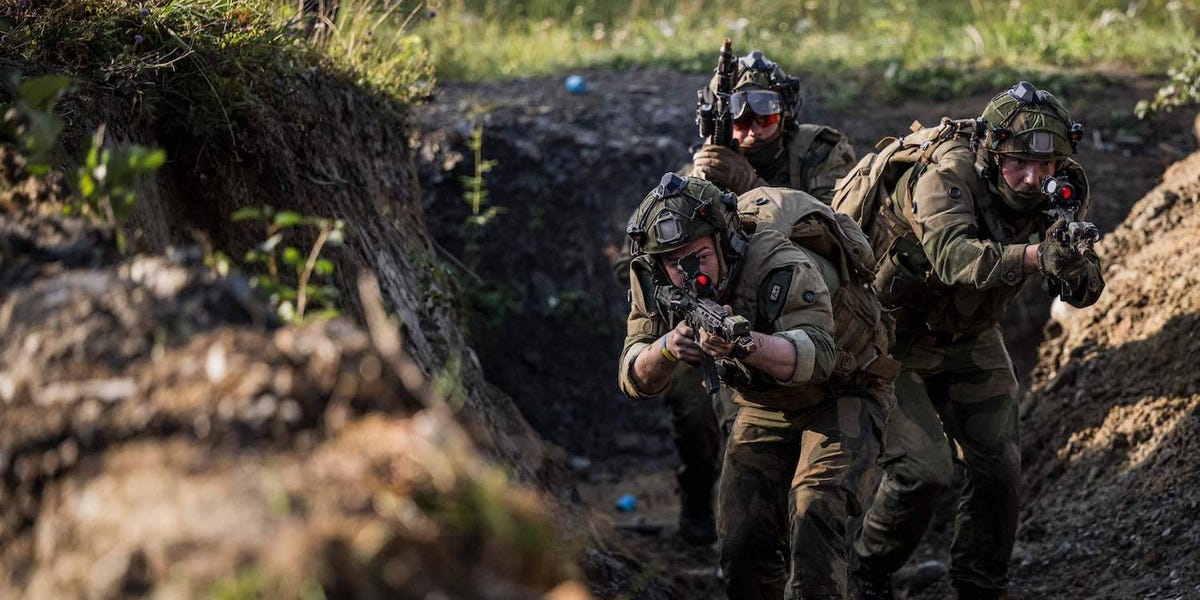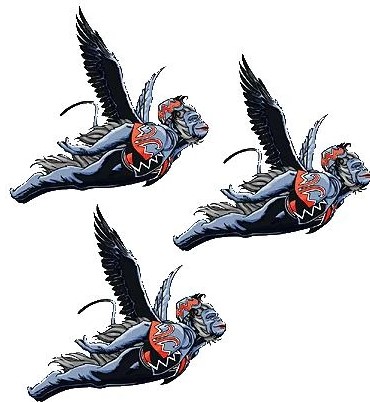Western-made armor is failing in Ukraine because it wasn’t designed to sustain a conflict of this intensity, a military analyst told The Wall Street Journal.
Taras Chmut, a military analyst who’s the head of the Come Back Alive Foundation, which has raised money to purchase and provide arms and equipment to Ukraine, said that “a lot of Western armor doesn’t work here because it had been created not for an all-out war but for conflicts of low or medium intensity.”
“If you throw it into a mass offensive, it just doesn’t perform,” he said.
Chmut went on to say Ukraine’s Western allies should instead turn their attention to delivering simpler and cheaper systems, but in larger quantities, something Ukraine has repeatedly requested, the newspaper reported.
They are talking specifically about tanks in the article. The armor on the tanks provided to Ukraine is allegedly not thought enough for mines, etc.
There isn’t enough armour in the world to stop a few proper anti-tank mines or anti-tank missiles or anti-tank drones.
Yeah, that’s what I wasn’t following. MBTs are going to need repairs, no matter how heavily armored, when you run them over a minefield, hit them with anti tank missles or drones. APVs aren’t designed to survive that, just to keep the occupants alive from something that would have turned them into a thick red mist.
Uh have they tried using anti mine systems to clear a path? I’m pretty sure western military doesn’t just go charging forward crossing their fingers…
For known minefields yes. For a regular road that might have one or two mines, no. Mine clearing is extremely slow. Even if you do it, someone might come in the night and plant more mines. The best you can do is keep an eye out for signs that mines have been planted.
The Russians made the defensive mine fields more than double the width of any mine clearing explosive device. This means they can’t quickly clear a section and move through without being sitting ducks.
Removed by mod
So… Basically, it’s not designed for use in a peer engagement?
Removed by mod
How’s that working out in Ukraine?
The Abrams was basically designed to take down insurgents in the Middle East lol
Considering the project that led to the Abrams was approved in 1973, it’s pretty clear who it was designed to fight.
The modern M1A2 came out in 1992, after the Gulf War. It’s something like 10 tons heavier than the original M1.
Removed by mod
The Abrams has seen action in… Iraq? Afghanistan? Both places where the US had complete superiority fighting against decidedly non-Soviet and non-Russian crews.
You could have put a Sherman covered in modern armour and with a modern gun and it would have done fine in Iraq and Afghanistan.
no, it’s because the core doctrine and design (at least of the leopard 1/2) is to use them in defensive battles against larger numbers of tanks - that was the entire NATO strategy in western Europe during the cold war, when all of that hardware was designed
not for rolling into unknown territory and getting hit by entrenched infantry AT, as Turkey discovered a few years ago
But… Isn’t that LITERALLY the exact doctrine the Nazis used to design their Tigers and Panthers?
The same tanks that, by the end of the war, were both outclassed and outnumbered by Soviet and American designs?
Why would the Nazis design for defensive operations.
Meanwhile the purpose of the Bundeswehr was literally to stall the enemy at the border until an army arrives.
At the end of 1941, Operation Barbarossa was decidedly a failure and Germany was facing mounting pressure in both the Atlantic and in North Africa. The Tiger entered service in 1942, the Panther entered service in 1943, and the Tiger II in 1944, when Nazi Germany was decidedly on the back foot and facing mounting pressure from the Soviets to the East.
You’re assuming that Nazi arms development had anything to do with military necessity instead of fewer dreams. Germany? On the defensive? That’s defeatist talk, any last words before your summary execution?
The prototype of the Tiger was called Durchbruchwagen, “breakthrough vehicle”. Not very defensive, also, development started way before Barbarossa. The Tiger that went into production then got even heavier armour and even larger gun because what the Heer had during Barbarossa was shit compared to what the Soviets fielded.
The Tiger’s system of interleaving road wheels weren’t designed for offensive operations in the muddy and wet Soviet Union and are much better equipped for land closer to Germany. Henschel and Porsche were told to submit updated designs ready by mid-1942 (Henschel ended up getting the contract). By that point, the Soviet Union was launching an aggressive counteroffensive on the Eastern Front.
What, exactly, other than vague discussions prior to the war for prototypes that were conceived of but never completed, suggests that the Tiger was designed for offense?
Removed by mod
If you trust what Congress keeps trying to ram down your throat, China.
First of all a “military peer” just means a nation that has similar military capabilities/power as oneself. And right now China is the only military peer to NATO, that is just a fact.
Second China is also positioning itself as a military adversary to NATO and its allies in many ways. And that is not the interpretation of “congress”, that is geopolitical reality.
China lacks capability to project power basically anywhere. Their north is covered by Russia (lol) and Mongolia (neutral and without significant marginal value). Their south is a dense jungle that’s basically impossible to properly invade (see: Vietnam, Korea, Vietnam 2). Their southwest is boxed in by the Himalayas that are literally the world’s biggest wall. Invading the west would basically be asking for ETIM 2. Invading over the ocean to the east is essentially impossible, and going from that straight into a densely-forested mountain or densely-populated city is even less possible.
China has no ways of being a military adversary because they, by geography, have no offensive options. The only thing China can feasibly go after is unpopulated “land” that’s basically free to claim.
You know the US is flanked on either side by oceans? Literally invading over an ocean is a thing we have been doing for over 100 years at this point.
Yeah, how’s that worked out?
Pulled out of Korea, pulled out of Vietnam, pulled out of Iraq, pulled out of Afghanistan.
The US achieves nothing through its invasions except (when successful) overthrowing a government and allowing a more corrupt and despotic government to take it’s place. Why would China want to do that?
NATO has no peers, so yes.
parts of that design difference is the size: western tanks are all larger silhouette, which they had to pay to have better accuracy at extreme ranges
afaik, they’re made for defense in depth and retreating at their effective range while thinning out attacking tanks
The large silhouette is more of an armour/survivability thing rather than a FCS/accuracy thing
The west probably should have anticipated having armour that works in these conditions. *Especially *considering they’ve been trying to get this war going for over a decade at least.
deleted by creator
deleted by creator
Removed by mod
The lack of air power is easily the biggest issue for Ukraine. NATO countries have made air superiority the central pillar of our strategic and tactical thinking since WW2, so it’s hard for us to adjust our thinking to a conflict where air power is thoroughly limited. While Ukraine has done an excellent job of neutralizing Russian air power, that just leaves the whole thing at a costly stalemate.
That said, I’m not sure what Ukraine expects to get out of this request for cheaper, more plentiful vehicles. It’s not like we can just design new IFVs for them in a matter of weeks. Maybe take existing designs and strip off any “unneeded” features? I don’t know how far that gets you, but probably not very far.
deleted by creator
Removed by mod
I remember back when Kosovo happened, and the claim was that the entire war would be won from the air, without ever putting boots on the ground. Farcical, but people honestly seemed to believe it.
That was shortly after the Gulf War where air dominance was the cornerstone of the coalition approach. The war opened with an all out deluge of “precision” strike bombings (of varying degrees of precision) and air power continued to play a key role throughout.
Go back before that and you’ve got carpet bombing in Vietnam, and before that you’ve got Bomber Harris and “reap the whirlwind.”
Air power is attractive because you can use a lot of money and technology, and very little manpower to make an outsized impact. That makes it very palatable to voters, so when you’re an alliance of mostly democratic nations you can wield air power with very little outlay of political capital.
It’s also clean and easy; there’s nowhere to hide in the air. If you can show up with more and better planes than the other guy, you’re basically guaranteed to dominate that theatre, and unlike naval power which more or less stops at the coastline, air power acts as a huge force multiplier to your actions on the ground. The US in particular loves air power because you basically just throw money at the problem and win every time.
With air superiority you can use tactical bombing and CAS to engage threats that your ground troops positively identify, while also giving precise spotting information to your artillery. Air and ground assets can work hand in glove to engage and destroy the enemy largely without ever having to directly engage them. The soldier on the ground becomes a pair of eyes for an A-10 or A-111. Every enemy tank, bunker or foxhole just becomes a new target for a maverick or paveway.
There are numerous problems with this strategy (we don’t talk about the friendly fire stats for the A-10), but on the whole it provides a very politically effective way of engaging in ground wars, one that tends to be high on collateral and civilian damage, but low on friendly troop casualties, and that’s what matters when you’re a NATO country. As long as the boys aren’t coming home in body bags, you can run up literally trillions of dollars in debt and no one will bat an eyelid.
It is a strange article. It argues that western armor isn’t designed for sustained conflict but offers up the solution of more cheaply made vehicles. I would assume that would greatly increase the number of human casualties. Can Ukraine sustain an increase of human loses? Training troops takes time also. The simple vehicles could make it easier to get troops training but I don’t know if trading troops is a good strategy when fighting a country with a higher population.
The thing is, an increase in armour casualties reduces infantry casualties by more than 1:1. There’s a reason the Tiger and Panther in WW2 are largely seen as strategic blunders today: a few complex and technologically superior tanks aren’t very useful, particularly if they require complex supply lines to support.
Yes true if they lack appropriate air support and logistics support. Which is the case for Ukraine.
Modern western strategy is very different from that of WW2. The key is integration of air support, artillery, armor, infantry, etc. If Ukraine had superior fighter jets, to gain air superiority and anti tank and anti personnel platforms like A10 and Apache, all platforms working in sync and all backed by logistics support to keep everything operating, it would be a different story I guess.
Related, I wonder if they’re suggesting the old Russian tanks would somehow perform better than the western ones? Because as far as I know, western tanks have the best armor systems, the highest accuracy, and the ability to fire while moving. Maybe they need to adapt their tactics to make better use of their platforms?
I suspect the doctrine for western tanks requires air dominance.
The context here is very specific : Ukraine is attacking a heavily fortified position.
In the beginning of the offensive, the losses were heavy because each time they would break a position with armor, Russians would unleash a barrage of artillery and air bombardments.
Then they changed their tactics, using the tanks as long range heavy direct fire support. And occasionally as spearhead or to counter a Russian offensive.
The biggest problem imo is the lack of air superiority : it makes them vulnerable to air bombardment when on a the front line, and it prevent them from doing deep strikes against artillery.
As they can’t prevent artillery or air bombardment, a heavy assault would inevitably suffer extreme losses, but with enough supplies, might be able to break through the line. But the few hundreds of western tanks are not enough for that. Or maybe Ukraine is “simply” afraid of losing too many of them in the offensive.
That’s the problem with few, expensive, good weapons: you need to be careful in using them because you can’t easily replace them. More numerous, inexpensive weapons would allow to take more risks, which might be necessary to win the war.
I don’t know about the US, but France and Germany do had this problem in mind IMO with their light tanks, the amx-30 and the leopard 1.
IMO the heavy tanks are good for an expeditionary force that will be limited in supplies, so it needs to make the most out of each vehicle it gets on the place. But for a large scale war of entrenched position, mass might be more important than raw quality.
More simply, even if you only lose 1 tank for 5 of the enemy, you still need more than a fifth of what they have.
I don’t know about the US, but France and Germany do had this problem in mind IMO with their light tanks, the amx-30 and the leopard 1.
The Leo1 isn’t lighter it’s simply the previous model of Leo and not significantly smaller, very much an MBT. You might be thinking of the Wiesel and generally tankettes.
It is very much an MBT, but it is lighter than most other tanks of this era (40t and rather light armor). The amx-30 is the same. US MBT are heavier and more armored in comparison, and with time all tanks got heavier and more armored still.
Not only that, but tanks are still much more survivable than infantry and each tank can replace multiple infantry.
Have you been watching General Dynamics promotional videos?
The early stages of the Ukraine war showed that even massive superiority in combined arms is useless because of how asymmetric warfare has become. Your million dollar tank is just as vulnerable to a $500 drone as a twenty thousand dollar Jeep. Your hundred million dollar jet is still going to get shot out of the air in a CAS role by a $10000 missile. The only wars that the West have been able to fight have been against insurgents riding in the back of old Toyota Hiluxes carrying Soviet-era AK-47s.
Modern Western tank doctrine values crew survivability, even at the cost of maintainability and production capacity. It’s the same design principle that the Nazis used to justify the Tiger, Panther, and Konigstiger (mind you, Nazi doctrine also relied heavily on tightly integrated combined arms).
Interesting. I know that Ukraine was given a bunch of handheld anti tank weapons to great effect. And I guess the Bradleys are supposed to be adept as tank killers?
I’m not sure what Russia has in the way of similar besides drones.
Why do they even need the M1 tanks?
I’m not sure what Russia has in the way of similar besides drones.
Russia has actually gotten quite good at drones.
But the Jeep vs. tank comparison is bunk, especially the direct dollar value comparison: Your million dollar tank shoots way further, hits way harder, and its crew will survive when hit. Instead of having to train a new one and write letters to their families you now have a veteran crew that probably learned an important lesson.
We’re seeing the opposite approach on the Russian side – have cheap tanks that blow up easily and take out the crew with them. They have lots of tanks, and also lots of people (at least in principle), but they don’t have nearly enough training capacity to teach new crews.
Even if Ukraine wanted to it could not afford that approach. Neither in terms of manpower, nor in political terms: As we all know war is the continuation of politics and not employing Soviet meat grinder doctrines is very much part of the whole not wanting to be Russia thing. If Ukrainians wanted to be subject to Dedovshchina they wouldn’t be fighting in the first place.
You could marginally increase the survivability of one tank (say, by 20%)… Or you could build another tank and increase the survivability of someone that would otherwise be infantry by an order of magnitude.
Tanks take bags of flesh off the battleground and that’s extremely advantageous.
The US operates under the assumption that they will be fighting a war on the other side of the world, so designing a more robust tank is important both in terms of PR (because dead bodies coming home is bad), in terms of logistics (because shipping twice the number of tanks around the world isn’t that great), and in terms of who they’re fighting (mostly insurgents without advanced anti-tank munitions, so survivability is far higher when hit).
Removed by mod
It was designed to make money for shareholders. Like every other piece of planned obsolescence trash that gets shit out now days.
This isn’t WW2, there’s plenty of anti tank weaponry available. It’s a lot cheaper than tanks and it’s going to do what it’s designed to do. Look how well tanks worked out for the Russians. Tanks are just not nearly as effective in modern warfare.
This is the best summary I could come up with:
Western-made armor is failing in Ukraine because it wasn’t designed to sustain a conflict of this intensity, a military analyst told The Wall Street Journal.
Taras Chmut, a military analyst who’s the head of the Come Back Alive Foundation, which has raised money to purchase and provide arms and equipment to Ukraine, said that “a lot of Western armor doesn’t work here because it had been created not for an all-out war but for conflicts of low or medium intensity.”
Despite Chmut’s comments, some advanced Western systems Ukraine has received were conceived with the highest-intensity combat in mind — NATO going head-to-head with Soviet forces.
The US-made Bradley infantry fighting vehicles and Abrams main battle tanks were built specifically to counter Soviet ground forces.
Ukrainian President Volodymyr Zelenskyy has repeatedly criticized Western allies for delays in the deliveries of weapons, saying earlier this month that slower arms shipments were hurting Ukraine’s chances of success in its ongoing counteroffensive.
Sergej Sumlenny, founder of the German think tank European Resilience Initiative Center, previously told Insider that Ukraine was stepping up its domestic production in part because of concern that Western deliveries would not keep up with its military needs.
The original article contains 468 words, the summary contains 197 words. Saved 58%. I’m a bot and I’m open source!
Basically it was designed for wiping out civilians in the off chance a few of them actually shoot back.
This is a nice way of saying "Where in the name of cyka are those F-16s?”
Are they saying that their tactics are the same as in WW2 and that’s the West’s fault?
Well we don’t give them planes, do we?
What about the 500 helmets we send from germany? I was told this is exactly what the Ukraine needed.
I’m not sure if you are joking, but in this case armor does not mean body armor, but tanks.
Sounds like a euphemism for confessing that Western made armor is poor-quality and vastly overestimates itself. Quelle surprise.
Removed by mod
deleted by creator
Incorrect doctrine usage ≠ poor quality














